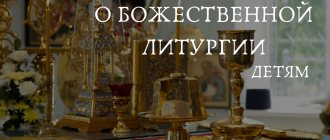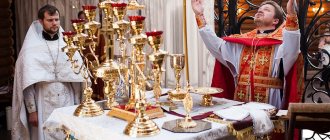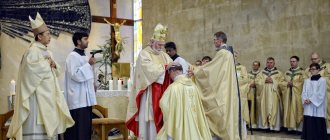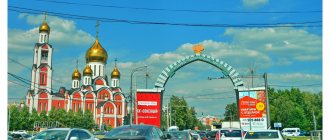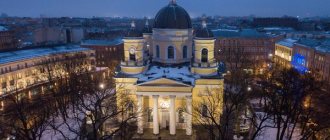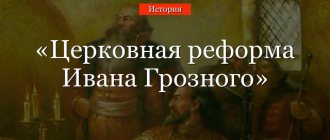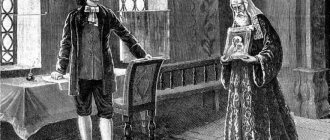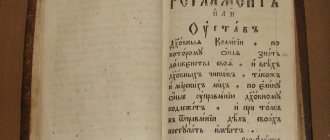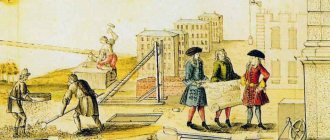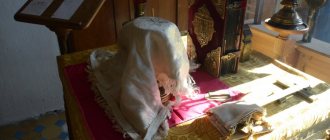Pope John XXIII, during his tenure as apostolic nuncio to Turkey in 1935, became a member of the Order of the Rose and Cross.
In this secret organization he received the mystical name John. The Italian writer Pir Capri wrote a book about this, “The Prophecies of Pope John XXIII.”
The Johannites, led by John XXIII, achieved the convening and holding of the Second Vatican Council, which changed the direction of Catholicism and revolutionized the liturgics and theology of the Roman Church of the Roman Catholic Church.
The Second Vatican Council was supposed to make the Roman Catholic Church open to the world
The Second Vatican Council is the XXI Ecumenical Council of the Catholic Church, opened in 1962 on the initiative of Pope John XXIII. It lasted for 3 years and was closed under Pope Paul VI.
3058
how many people participated in the Second Vatican Council
It adopted a number of important documents related to church life - 4 constitutions, 9 decrees and 3 declarations. The Council was attended by 3,058 people - bishops and superiors general of monastic orders and congregations.
Also present were laypeople, observers of other faiths, and the diplomatic corps.
Second Vatican Council. 1962 - 1965. The Second Vatican Council was convened to renew the Catholic Church. Photo: upload.wikimedia.org
At the opening of the Council on October 11, 1962, Pope John XXIII declared that its goal was the renewal of the Roman Catholic Church and its reasonable reorganization. This is necessary so that she can demonstrate her understanding of the development of the world and connect to this process.
In addition, the Pope expressed the wish that the result of this Council would be a Church open to the world. The task of the Council was to carry out long-overdue reforms in church life.
Meeting of the Patriarch and the Pope
The decisions taken on reforms in Catholicism caused the rejection of the most conservative part of the Catholic community, some of which found themselves in a virtual schism with the Church (the Priestly Fraternity of St. Pius X), some support the movement for the preservation of the pre-reform rite within the Church (Una Voce).
The Second Vatican Council was supposed to continue the unfinished First Vatican Council
3 months after his election to the papal throne, on January 5, 1959, Pope John XXIII announced his intention to convene an Ecumenical Council. For this purpose, on May 17 of the same year, a preparatory commission was formed, the chairman of which was the Vatican Secretary of State, Cardinal Domenico Tardini.
January 5, 1959
on this day the Pope announced the convening of the Ecumenical Council
At the same time, the convening of the next Roman Catholic Ecumenical Council has been put forward at the highest level since the first quarter of the 20th century. On December 23, 1922, Pope Pius XI published the encyclical Ubi arcano, which outlined the program of his pontificate.
In it, he for the first time publicly expressed his wish for a possible resumption of the work of the unfinished First Vatican Council, interrupted in 1870.
His Holiness Pope Pius XI. Pius XI was the first to express the idea of convening the Second Vatican Council. Photo: upload.wikimedia.org
The Pope ordered the systematization of the archives of the First Vatican Council, as well as the beginning of research into its materials, while they also included those documents that the First Vatican Council did not discuss.
They were published later by Popes Pius IX and Leo XIII in five volumes in the collection “Acta Congregationum generalium”.
June 25, 1959
on this day the Pope outlined the main goals of the upcoming Council
On June 29, 1959, Pope John XXIII issued the encyclical Ad Petri Cathedram, in which he briefly outlined the goals of the upcoming council: “the development of the Catholic faith, the renewal (aggiornamento) of Christian life, the adaptation of church discipline to the needs and customs of our time.”
The news of John XXIII's intentions was a complete surprise to many; even the official Vatican press initially kept silent about them: information about the planned Council first appeared in the official newspaper L'Osservatore Romano on February 1.
The Second Vatican Council continued the First, whose work was not closed.
On March 4, 1848, the pope ordered the creation of a preparatory commission that would prepare documents for future discussion.
By May 30, 1960, the commission had received more than 3 thousand responses and proposals. On June 5, 1960, in a motu proprio "Superno Dei nutu", the Preparatory Commission was transformed into the Central Preparatory Commission.
Its work was headed by the pontiff himself or his legate, the dean of the College of Cardinals, Eugene Tisserand. On December 25, 1961, the bull “Humanae Salutis” was issued. It justified the need to convene the Council and set the date for the start of its work.
His Holiness Pope Saint John XXIII. Pope Saint John XXIII is the direct initiator of the convening of the Second Vatican Council. Photo: upload.wikimedia.org
On June 20, 1962, the work of the Central Commission was completed, having prepared 73 draft documents.
However, most of them had not yet been fully worked out and were left for revision by the cathedral itself. On August 6, 1962, the statutes of the council were published in the motu proprio “Appropinquante Concilio”, defining the rules for holding meetings, voting procedures, the degree of participation of observers, etc.
August 6, 1962
on this day the Charter of the Council with basic rules was published
Representatives of 28 Christian Churches and denominations were invited to participate as observers. The language chosen by the Second Vatican Council was “Latin” - the language spoken by the “Church of Christ”.
background of the cathedral
Already in the first half. In the 19th century, a strong modernist current with a collectivist, socialist tint emerged in Catholicism. At the same time, Uniate preaching is intensifying in the Slavic world, including among the Russian intelligentsia. By such means, Catholicism is trying to overcome, or rather rethink, its political, social and state defeat in Italy, France and Germany, where nationalism and Freemasonry pursued a fierce anti-Catholic policy.
Catholicism as a whole has found it impossible to directly attack modern civilization. Reconciliation with the new anti-Christian order in Europe becomes the main line of thought for official Catholicism.
Having suffered a temporary setback in 1907, when Pope Pius X condemned modernism as heresy, theological modernism, ecumenism and secularism went temporarily underground.
In con. 20s modernism is being revived, in particular, in such intellectual centers as Louvain, Fourvières and Solchoir, in the movement of liturgical renewal and in the beginning. 40s – in the “worker-priests” movement. Such major figures of the future fathers of the Second Vatican Council as Yves Congar, Henri de Lubac, J-M. Chenu, Louis Bouyer, Augustin Bea and others. Official Catholic initiatives also played into this: in the encyclical of Pius XI Quas Primas (1925), the new social teaching of the First Vatican Council about Christ the King received its final form.
In 1943, the encyclical Divino afflante Spiritu appeared, which opened the way for the penetration of destructive techniques of biblical criticism into Catholicism.
Despite persecution under Pius XII in the 40s and 50s, the modernist underground in its three main directions - modernism, liturgical reform, secularization (socialization) - happily survived until the pontificate of John XXIII, when it was able to openly declare itself.
The Second Vatican Council took place over 3 years
On October 11, 1962, the inauguration of the Second Vatican Council took place. It was attended by 2540 participants.
In addition, observers from other Christian churches arrived at the opening ceremony: representatives of the Russian Orthodox Church, Old Catholics, Anglicans, etc. The work of the first session continued until December 8.
Draft documents on the Church, on the sources of Revelation, on the means of mass communication and a number of others were discussed.
Not a single document was adopted, but a large number of amendments and proposals were formulated and sent to the council commissions, which were supposed to continue their work between sessions.
Session of the Second Vatican Council. A total of four sessions were held during the work of the Council. Photo: upload.wikimedia.org
On June 3, 1963, the organizer and inspirer of the Council, Pope John XXIII, died. Instead, a new Pope, Paul VI, was elected and the Second Session of the Council, which took place from September 29 to December 4, 1963, was opened by him.
There were heated debates on draft documents on the Church in the modern world, on ecumenism (interaction with non-Christian religions and non-Catholic churches) and religious freedom.
No documents on these topics were adopted at the session. The first documents approved by the council were the constitution on the liturgy Sacrosanctum Concilium and the decree on relations with the media Inter Mirifica.
4
so many sessions took place at the Second Vatican Council
The Third Session of the Council lasted from September 14 to November 21, 1964. On September 19, it adopted a large number of documents, including the most important document - the Dogmatic Constitution on the Church (Lumen Gentium).
It became the product of a compromise between the progressive and integrative movements in the Roman Catholic Church. In addition to the constitution, the third session also adopted two decrees - Unitatis redintegratio (on Catholic ecumenism) and Orientalium Ecclesiarum (on the Eastern Churches).
Photo of Paul VI, photographer Lothar Wollech. Pope Paul VI continued to lead the Second Vatican Council and concluded it after the death of Saint John XXIII. Photo: upload.wikimedia.org
The final session of the Council began on September 14 and lasted until December 8, 1965. All other documents of the Council were adopted at it.
The greatest controversy was caused by the declaration of Dignitatis humanae on religious freedom.
The Declaration was sharply criticized by integrators for its liberal understanding of freedom of conscience.
And also for the vagueness of the concept of “freedom of religion”; as well as the constitution on the Church in the modern world Gaudium et spes.
Because of disagreements between the Integrists and the Progressives, it was framed as a pastoral rather than a dogmatic constitution only after the pope's open demand to do so.
This means its declarative, not doctrinal, nature. Another important document adopted at the final session was the constitution on Divine revelation Dei Verbum.
participants
More than 2 thousand members took part in the Second Vatican Council. In addition to John XXIII's direct collaborators, periti (experts) played a very important role in the manipulation of the council.
The central figures of the Second Vatican Council were Cardinals Augustin Bea, Joseph Frings and L.-J. Sunens, as well as Henri de Lubac, Yves Congard, M.-D. Shenu. The cathedral was attended by: Cardinal Franz Koenig, Bud. Cardinal Jean Danielou, b. Cardinal Johannes Willebrands, Karol Wojtyla (future Pope John Paul II), Joseph Ratzinger (future Pope Benedict XVI), Hans Küng, E. Schillebeeks, head of the Ukrainian Uniates Joseph Slipy, Uniate “archimandrites” Emmanuel Lannes and Eleuferio Fortino, bishop . Rudolf Graber et al.
Orthodox observers
Pope John XXIII and observers from the Russian Orthodox Church at the Second Vatican Council: Archpriest Vitaly Borovoy and Archimandrite Vladimir (Kotlyarov).
The council was attended by the elite of Orthodox and Protestant modernism: Bishop. Cassian (Bezobrazov), Metropolitan. Emilian (Timiadis), Fr. Nikolay Afanasyev, Fr. Alexander Schmeman, Nikolai Arsenyev, Pavel Evdokimov, Nikos Nissiotis, representatives of the community Tese “brother” Roger and Max Tourian, Lukas Vischer, Edmund Schlink, etc. Fr. Alexander Schmeman denied that he was an official observer from the American Metropolis, but was present at cathedral privately, as a special guest.
The Patriarchate of Jerusalem and the Church of Greece refused to send a delegation to the Second Vatican Council.
The possibility of the presence of observers from the Russian Orthodox Church was discussed in March 1959 at a meeting of Metropolitan. Nikolai (Yarushevich) with the Chairman of the Council for the Affairs of the Russian Orthodox Church G. G. Karpov. It was decided not to exclude the possibility of sending representatives. In a conversation with the same G. G. Karpov at the beginning. April 1959, Patriarch Alexy I spoke extremely negatively about the very idea of delegating representatives of the Russian Orthodox Church to the Catholic Council.
Thanks to the direct participation of Metropolitan. Nicodemus (Rotov), representatives of the Russian Orthodox Church were sent to the Second Vatican Council. During a secret meeting in August 1962 in Paris with Joseph Willebrands, Met. Nikodim (Rotov) reported that “the Kremlin could agree to the presence of observers of the Russian Orthodox Church at the Second Vatican Council if the Vatican could guarantee that this Council would not become an anti-Soviet forum.” On October 10, 1962, the Holy Synod decided to accept the Vatican's invitation to send observers. The delegation included: Metropolitan. Nikodim (Rotov), bud. Metropolitan Vladimir (Kotlyarov), bud. Metropolitan Yuvenaly (Poyarkov), Fr. Vitaly Borovoy, Fr. Liveriy Voronov.
Throughout the Second Vatican Council, observer meetings were held once a week, during which Augustine Bea commented on the ongoing work of the council, and observers were invited to make critical comments on the draft documents under discussion. Before the start of the Second Vatican Council, Vatican Secretary of State Cicognani received the observers and presented them with commemorative medals of his pontificate on behalf of John XXIII.
Father Vsevolod Shpiller spoke about the Second Vatican Council:
What an exhaustively clear picture of everything that happened at the Council! You breathe the air that the Cathedral breathes. How well His boldness and prudent caution are shown, not only the general direction, but also the inner meaning and significance of the aggiornamento of the Church. No, no attempts to devalue the ever-deepening and rising, ever-expanding and intensifying meaning and meaning of aggiornamento, no irony over this word will now in any way and will ever diminish the power of the movement that emerged from the spiritual, I want to say, from the sacred depth of genuine conciliarity, genuine catholicity Church" [1].
The result of the Second Vatican Council was the adoption of a large number of documents
On December 8, the closing ceremony of the Council took place on the square in front of St. Peter's Basilica, which was attended by about 2 thousand Roman Catholic bishops, representatives of almost 100 states and approximately 200 thousand people.
Participants leave St. Peter's Basilica. After the end of the fourth session, the Second Vatican Council ceased its work. Photo: upload.wikimedia.org
The Second Vatican Council adopted 16 documents (4 constitutions, 9 decrees and 3 declarations):
Constitution:
- "Sacrosanctum Concilium" - a constitution on the sacred liturgy.
- "Lumen Gentium" is a dogmatic constitution about the Church.
- "Gaudium et Spes" is a pastoral constitution on the Church in the modern world.
- "Dei Verbum" is a dogmatic constitution about divine revelation.
16
so many documents were adopted at the Second Vatican Council
Decrees:
- “Ad gentes” is a decree on the missionary activities of the Church.
- "Orientalium Ecclesiarum" - decree on the Eastern Catholic Churches.
- "Christus Dominus" is a decree on the pastoral ministry of bishops in the Church.
- “Presbyterorum ordinis” is a decree on the ministry and life of elders.
- "Unitatis redintegratio" - decree on ecumenism.
- “Perfectae caritatis” is a decree on the renewal of monastic life in relation to modern conditions.
- "Optatam totius" - decree on preparation for the priesthood.
- “Inter mirifica” is a decree on the means of mass communication.
- "Apostolicam actuositatem" - decree on the apostolate of the laity.
Lumen Gentium (from Latin - “Light to the Nations”) is the dogmatic constitution of the Second Vatican Council of the Catholic Church.
Considered one of the main documents adopted by the Second Vatican Council, the Declaration:
- "Dignitatis humanae" is a declaration of religious freedom.
- “Gravissimum educationis” is a declaration of Christian education.
- "Nostra ætate" is a declaration of the church's attitude towards non-Christian religions.
Pope Pius IX (1846 - 1878), during whose pontificate the doctrine of the infallibility of the Pope was adopted at the First Vatican Council.
The dogma of the infallibility of the Pope was confirmed by the Second Vatican Council. Photo: upload.wikimedia.org To implement the conciliar decisions, on January 3, 1966, the pope motu proprio “Finis Concilio” created post-conciliar commissions on bishops and the administration of dioceses, on monasticism, on missions, on Christian education.
Also for the laity and the central post-conciliar commission for the interpretation of conciliar decrees, which is responsible for coordinating the work of all post-conciliar commissions.
Pope John XXIII on January 25, 1959, 3 months after his election to the throne, in the Roman Basilica of St. Paul (San Paolo fuori le Mura) made the first official announcement of his intention to convene a new Ecumenical Council of the Catholic Church. He called the main tasks of the Council a return to ancient forms of presentation of religious doctrine, streamlining of church discipline, revitalization of religious life, and also highlighted the ecumenical aspect.
Preparation period
In early February 1959, the text of the pope's speech of January 25 was submitted to the members of the College of Cardinals for consideration. After this, responses and proposals regarding the topic of the Council began to arrive in Rome. To summarize all wishes and proposals, a Preparatory Commission (PPC) was created on May 17, 1959. The prefect of the Congregation for Extraordinary Ecclesiastical Affairs, Vatican Secretary of State, Cardinal Domenico Tardini, was appointed its chairman.
At the first working session of the Preparatory Commission, which opened on May 26, 1959, it was stated that the convened Council was focused on solving current problems of the Roman Catholic Church and did not aim to complete the doctrinal definitions of the First Vatican Council. The official language of the convened Council is Latin. On June 18, almost 2,800 letters were sent to prelates and abbots, resident and titular bishops, nuncios, vicars and apostolic prefects, superiors general of brotherhoods and congregations.
By May 30, 1960, the Preparatory Commission had received more than 2 thousand responses (vota) from bishops, classified by subject and topic.
In the motu proprio Superno Dei nutu [1] of June 5, 1960, Pope John XXIII officially established the name of the Council as the Second Vatican Council, defined its tasks, established a Central Preparatory Commission, 10 Preparatory Commissions for various issues and 3 secretariats. Established the procedure for their formation (all members of the Preparatory Commissions are appointed by the pope, the chairman of each commission is a cardinal).
It took about three years to prepare the cathedral. During the preparation, over 2 thousand church hierarchs from five continents were interviewed. Their proposals and considerations amounted to several dozen volumes. 70 documents were prepared for discussion at the council. Tourists, journalists, radio and television commentators came to Rome from all over the world. On March 19, 1961, Saint Joseph the Betrothed was proclaimed patron (Patron) of the Vatican Council.
On December 25, 1961, John XXIII signed the apostolic constitution Humanae salutis, dedicated to the problems of modern society, the crisis of its spiritual state against the background of material progress. Her dad justified the need to convene a “new Ecumenical Council” and declared 1962 the year its work began. At the same time, the pope declared the First Vatican Council closed. By decision of February 2, 1962, he announced the start date of the Council for October 11, 1962.
On June 20, 1962, the final session of the Central Preparatory Commission was held. On August 6, 1962, Pope John XXIII signed the motu proprio Appropinquante Concilio[2]. The 70 articles of the Charter of the Vatican Council (Ordo Concilii) set out the rules for holding meetings, the ranks and rights of Council participants, the degree of participation of non-Catholic theological consultants and observers in the Council, and the voting procedure. The general leadership of the general congregations was entrusted to the Council of the Presidium, composed of 10 cardinals appointed by the pope. 10 Council Commissions were established, each of which consisted of 26 members (16 were elected by council vote, 10 were appointed by the pope).
At the preparatory stage of the Council, different expectations began to emerge from the work of the Council and its results. The Curial apparatus, forming the composition of the Preparatory Commissions, sought to reduce the renewal of the Roman Catholic Church, declared by Pope John XXIII, to a minimum, and to preserve the traditional provisions of the doctrine in integrity. This is where they are called “integrators”, from the Latin integrum – holistic. The consultants of the Preparatory Commissions, supporters of renewal (Jean Danielou, Yves Congard, Henri de Lubac, Karl Rahner, Edward Schillebeex) began to be called “progressives”.
The Orthodox East and especially the Russian Orthodox Church from the very beginning expressed a reserved position towards the Second Vatican Council. This can be understood if we recall the mutual alienation of the Western and Eastern Churches, which lasted almost 1000 years. During this time, many disagreements accumulated, due to which the Orthodox, as well as the Catholics, lost a lot. In this regard, the position of the Russian Orthodox Church was extremely cautious even regarding the proposal to send an observer to the Council. The Russian Orthodox Church, with its restraint, made it clear to the Roman Throne that it did not find it possible for itself to attend “a Council that would combine an anti-Orthodox mood with a hostile attitude towards the countries of the East”[3].
“For centuries, Catholics thought they were clear enough about their doctrine. Non-Catholics did the same. Each explained his point of view, using his own terminology and taking into account only his own view of things; but what was said by Catholics was poorly received by non-Catholics, and vice versa. Using this technique, no progress was made towards unity."[4]
A certain obstacle was also the relationship between the atheistic state and the Church. The Russian Orthodox Church could not hold any events in the international arena without the permission of the state. At that time, there were unwritten contractual agreements between the Russian Orthodox Church and the Soviet State. From an ecclesiastical point of view, the possibility of Russian Orthodox participation at the Latin Council was excluded. This was stated by His Holiness Patriarch Alexy (Simansky) at a meeting with Karpov in early April 1959. He said: “According to existing canonical laws, the Orthodox Church does not have the right to participate in this Council, nor to send its representatives as guests or observers; on the contrary, we have taken measures, the Patriarch said, that could diminish the significance of the Council. Thus, the Patriarchate intends to intensify its activities towards rapprochement with the ecumenical movement by expanding contacts and participating in conferences as observers”[5]. From this it is clear that the Patriarch, like the entire Russian Orthodox Church, had no desire to participate in the Council led by Catholics.
Patriarch Alexy (Simansky) conveyed to the Chairman of the Council Karpov that such actions of the primate were dictated by considerations of a purely church canonical nature, in the spirit of the traditional opposition of Russian Orthodoxy to Rome. Karpov Georgy Grigorievich, chairman of the Council for the Affairs of the Russian Orthodox Church under the Council of Ministers of the USSR, was replaced in his post on February 21, 1960 by Vladimir Alekseevich Kuroyedov, a former party apparatchik from the Department of Agitation and Propaganda of the CPSU Central Committee, secretary of the Sverdlovsk regional committee of the CPSU. A pragmatic person who observed unwritten agreements between the Church and the state gave way to a functionary who implemented the ideological line approved by the CPSU Central Committee for the development of an anti-religious struggle.
On June 17, 1962, Kuroyedov directly stated to Metropolitan Nikolai (Yarushevich) of Krutitsky and Kolomna, Chairman of the Department of External Church Relations, about the ineffectiveness of the external activities of the Church and demanded his resignation from his post. Metropolitan Nikolai (Yarushevich) resigned on June 21, and on September 19, 1960, by resolution of the Holy Synod, he was released from his church position. He died on December 13, 1961 after an injection with an unknown drug given by a nurse.
Metropolitan Nikolai (Yarushevich) was replaced by Archimandrite Nikodim (Rotov), whose episcopal consecration took place on July 10, 1960 as Bishop of Podolsk. With the arrival of Bishop Nikodim, the concept and conduct of the foreign policy of the Patriarchate radically changed.
The Pope attached exceptional importance to the presence of observers from the Russian Orthodox Church at the Council. The first contact with a representative of the Russian Orthodox Church was made in August 1962 on the university campus in Paris. Meetings of the International Council of Churches were held there. The Vatican Secretary of the Commission for Promoting Christian Unity, Cardinal Willebrands, spoke with Bishop Nicodemus about the upcoming Council. The latter expressed regret that no invitation to Moscow was sent. The Vatican sent an invitation to all Orthodox Churches, but it was sent to the Patriarch of Constantinople. The Latins were confident that this was enough, based on their own experience.
Orthodox Christians are alien to rigid centralization. The Russian Orthodox Church has autocephaly. Therefore, our Patriarchate wanted to negotiate with the Vatican directly. It turned out that the Kremlin could agree to the presence of observers of the Russian Orthodox Church at the Second Vatican Council if the Vatican could guarantee that this Council would not become an anti-Soviet forum. The second contact with the Vatican regarding observers at the Council took place on August 18, 1962 in France at the house of the Little Sisters of the Poor in Metz - it was a large garden surrounded by walls. At this meeting, Archbishop Nikodim and Cardinal Willebrands agreed that if the Council did not condemn communism, but focused on the struggle for universal peace, then this would provide an opportunity for those invited from the Moscow Patriarchate to attend.
In September, a few weeks before the opening of the Council, the Roman Catholic Church sent the secretary of the “Secretariat for the Promotion of Christian Unity,” Monsignor Willebrands, to Moscow. During his stay in Moscow from August 27 to October 2, 1962, Willebrands outlined the purpose of the trip: “to inform the Moscow Patriarchate about the progress of preparations for the Second Vatican Council, the stages of this preparation, as well as about the tasks of the Council, issues scheduled for resolution, and about the council procedure.” [6].
The result of this visit was a change in the position of our Church in relation to the Vatican Council. At the invitation of the Chairman of the Secretariat for Promoting Christian Unity Cardinal Bea, His Holiness Patriarch Alexy of Moscow and All Rus' and the Holy Synod on October 10, 1962 decided to send to the Second Vatican Council as their observers: the acting representative of the Russian Orthodox Church at the World Council of Churches, professor of the Leningrad Theological Academy, Archpriest Vitaly Borovoy and deputy head of the Russian Ecclesiastical Mission in Jerusalem, Archimandrite Vladimir (Kotlyarov). The “Regulations on observers of the Moscow Patriarchate at the Vatican Council” were adopted, according to which they had to “regularly, at least once a week, report on the current work of the Council to the chairman of the DECR,” accompanying their reports with printed materials of the Vatican Council, current periodicals and publications. The observers were also charged with the responsibility “if necessary, to present to the appropriate authorities of the Roman Catholic Church a certain position of the Moscow Patriarchate”[7]. On the same day, by a resolution of the Presidium of the CPSU Central Committee, consent was given to sending representatives of the Moscow Patriarchate as observers to the Vatican Council[8].
The presence of Russian observers at the Council attracted everyone's attention. In addition, 86 official delegations from various countries and from various international organizations were present at the opening of the Council.
The first session was attended by Protopresbyter Vitaly Borovoy and Archimandrite Vladimir Kotlyarov as observers from the Russian Orthodox Church.
The second session of the Council was attended by Protopresbyter Vitaly Borovoy and Protopresbyter Iakov Ilich.
On the third, Protopresbyter Vitaly Borovoy and Associate Professor of the LDA Archpriest Liveriy Voronov.
On the fourth, Protopresbyter Vitaly Borovoy and Archimandrite Yuvenaly (Poyarkov).
The Vatican Council was also attended by a delegation of observers from the Russian Orthodox Church Abroad: Bishop Anthony (Bartoshevich) of Geneva, Archpriest I. Troyanov and S. Grotov and a delegation from the St. Sergius Theological Institute in Paris - rector Bishop Cassian of Catania (Bezobrazov) and Archpriest A Schmemann.
First session of the Council
October 11 – December 7, 1962
On October 11 at 8 o'clock in the morning, in a solemn atmosphere in the sparkling lights of St. Peter's Cathedral, the first session of the XXI Ecumenical Catholic Calculus, or, as it came to be called, the Second Vatican Council of the Catholic Church, opened. If only 764 bishops took part in the first Vatican Council, two-thirds of them Europeans, now 3,058 bishops and superiors general of monastic orders and congregations sat on the stands in mitres and magnificent medieval robes. This time, Europe was represented by 849 conciliar fathers, North and South America - 932, Asia - 256, Africa - 250, Oceania - 70.
Near the pope's box were delegations from 17 different non-Catholic Christian churches - the "breakaway brothers." Among them were representatives of the Russian Orthodox Church, as well as various Protestant movements.
The pope appointed 10 members to the presidium, who presided in turn. The meetings began with a prayer, which was said alternately in Latin and Greek. Microphones were placed everywhere, radio headphones were hung on chairs, and there was a lot of other equipment, without which it would have been very difficult for the cathedral fathers to carry out their important event[9]. The council took place in the Basilica of St. Peter's in Rome; 4 sessions were held, 168 general congregations.
Pope John XXIII delivered the opening speech at the Council. The speech lasted 45 minutes and was called Gaudet Mater Ecclesia[10]. The Pope stated that the task of the Council is not so much to condemn errors and proclaim anathemas, but rather to ensure that the Church wishes to show mercy. This is necessary to build bridges of human brotherhood over the abyss of ideological and political confrontation between East and West.
The first session of the council was supposed to consider five projects: On the liturgy, On the sources of God's revelation, On the media, On unity with the Eastern (Orthodox) Churches and, finally, a project for the structure of the Church, which was called De ecclesia and was one of the main themes of the Council. A lot of controversy was caused by the discussion of the scheme On the Liturgy. It dealt with the reform of worship. The form of the Catholic Liturgy was approved by Pope Pius V in 1570 and has not changed since that time. To make worship more accessible and understandable to believers, the Council was offered a scheme to simplify the Liturgy. The rapporteur on this issue was Cardinal Ottaviani.
The journal of the Moscow Patriarchate gave the following assessment of the first session of the Second Vatican Council: “After the first session of the council, the significance of the Second Vatican Council is already recognized by everyone, and, mainly, because of those significant, even fundamental changes that are outlined not only in the internal life of the Catholic Church, but also in its relationships with the outside world”[11].
Pope John XXIII fell ill, so he followed the meetings of the Council on television. On December 4, he wished to speak at the Council. In his speech, he positively assessed the work of the Council, thereby supporting the progressives. The Pope elevated the Archbishop of Milan, Giovanni Battista Montini, the future Pope Paul VI, to the rank of cardinal. In him John XXIII saw his successor. The Pope asked Cardinal Montini to rise above conciliar discussions, maintaining his impartiality in the interests of the unity of the Church.
On December 8, the first session of the Vatican Council was closed. None of the documents discussed there were adopted. On November 27, the pope officially announced the opening of the second session of the Vatican Council, scheduled for September 8, 1963.
In response to a question from Italian radio and television correspondent P. Branzi about the attitude of the Russian Orthodox Church to the Second Vatican Council, the Chairman of the Department for External Church Relations, Archbishop of Yaroslavl and Rostov Nikodim said: “The Russian Orthodox Church, in the spirit of unfeigned brotherly love (1 Peter 1:22) responded to the invitation send its observers to the first session of the Second Vatican Council. Its observers actively delved into the course of the conciliar discussions and showed a keen interest in everything that could contribute to the future establishment of fraternal Christian relations with the Roman Catholic Church on the basis of mutual understanding and a joint desire to contribute to the cause of peace and progress of mankind.”[12]
After the death of the pope, Patriarch Alexy sent a telegram of condolences addressed to Cardinal Cicognani. “The Russian Orthodox Church and I deeply mourn the death of His Holiness Pope John XXIII. We heartily share the grief of the Church, which has lost its outstanding Head and High Priest in the person of the late pope. We believe that in the hearts of all people striving for peace, the grateful memory of the hard work of the deceased to preserve and strengthen peace on Earth will forever remain. We offer fervent prayers for the repose of the bright soul of the deceased Holy Father in the last refuge of the righteous.”[13] On June 17, 1963, on the day of the funeral of John XXIII, a memorial service was held for the newly deceased pope in the Cross Church of the Patriarch's residence in Moscow.
The Izvestia newspaper wrote: “Not one of the popes aroused so much sympathy from ordinary people during his lifetime and such genuine grief after death... The deceased pope set the task of building a world without wars... He fulfilled this task in a new way and with great courage.”[14] .
The death of Pope John XXIII followed on June 3, 1963, sparking discussions about the possibility of continuing the Vatican Council. However, the new Pope Paul VI, immediately after his election on June 21, in his address urbi et orbi, officially announced his intention to continue the work of the Council, postponing the opening of the second session from September 8 to 29. On September 14, Pope Paul VI signed the appeal to the episcopate Eum proximis and the letter Chorum temporum.
Second session of the Council
September 29 – December 4, 1963
At the opening ceremony, Pope Paul VI delivered what some have called an oral encyclical. In this speech, he formulated 4 topics that were subject to discussion at the Council as a whole: the dogmatic teaching of the Church and the doctrine of the episcopate, the renewal of the Church, the restoration of the unity of Christians, the dialogue of the Catholic Church with secular and ecclesiastical organizations. Addressing non-Catholic observers, the pope asked for forgiveness for insults previously inflicted by Catholics, confirmed his readiness on behalf of all Catholics to forgive insults and others for their insults inflicted on Catholics. Regarding the need for renewal of the Catholic Church, the Pope said: “The Church is essentially a mystery. This mystery is related to the reality of God's hidden presence in the world. This reality represents the very essence of the Church, and will always need new research and revelation of its essence”[15]. For the first time, the pope announced the need to hold subsequent sessions of the Council to finally resolve all issues.
Pope Paul VI appointed 3 new cardinals to the Council of the Presidium of the Council (Primate of Poland Stefan Wyszynski, Archbishop of Genoa G. Siri and Archbishop of Chicago A. G. Mayer). On September 8, the pope established a conciliar press committee headed by Archbishop M. J. O'Connor.
From September 30 to October 31, the project About the Church was discussed. There were many controversial points here, in particular the question of the establishment of a married diaconate, the introduction of the doctrine of the Virgin Mary into the constitution, and the question of the role of the laity in the life of the Church.
During a public session on December 4, 1963, Paul VI solemnly proclaimed the Constitution Sacrosanctum Concilium (On the Sacred Liturgy) and the Decree Inter mirifica [16] (On the Means of Mass Communication) adopted by the Council. At the same time, the pope used the formula approbamus una cum patribus[17], and not the right ex cathedra, and thus the proclaimed documents acquired a disciplinary and recommendatory, but not dogmatic character.
Third session of the Council
September 14 – November 28, 1964
At the third session of the Council, at the proposal of Cardinal Suanens, 16 Catholic women were present among the lay observers. The speech delivered by Pope Paul VI at the opening of the sessions concerned the main task of the session: the development of the teaching of the First Vatican Council on episcopacy, the nature and ministry of bishops, their relationship with the pope and the Roman Curia.
The Constitution Lumen Gentium[18] (On the Church) and the two decrees Unitatis redintegratio[19] (On Ecumenism) and Orientalium Ecclesiarum[20] (On the Eastern Catholic Churches) were signed by Pope Paul VI on November 21, 1964 at the closing ceremony of the Third Session.
On January 4, 1965, the pope officially set the opening of the fourth session for September 14, 1965.
On January 27, 1965, the Decree “On Amendments to the Rite of Mass” was published. On March 7, in the Roman Church of All Saints, Pope Paul VI celebrated Mass for the first time according to the “new” rite - facing the people, in Italian, with the exception of the Eucharistic canon.
Fourth session of the council
September 14 – December 8, 1965
On October 28, 1965, on the occasion of the seventh anniversary of the election of Pope John XXIII, it was decided to hold a solemn ceremony and public session at which the voting and solemn proclamation of 5 conciliar documents took place.
On November 9, 1965, in an apostolic letter Extrema sessio addressed to the first present Cardinal Tisserand, Pope Paul VI announced that the closing of the Second Vatican Council would take place on December 8.
End of the Council's work
After the Mass to mark the end of the Second Vatican Council, Pope Paul VI delivered a speech on the results of the Council. Then a Joint Statement of the Roman Catholic and Orthodox Churches of Constantinople was announced, which declared that Pope Paul VI and Patriarch Athenagoras of Constantinople, for the sake of developing the “fraternal relations” that had arisen between the Churches, wished to remove “certain obstacles” to these relations, namely mutual anathemas of 1054, and expressed mutual regret for “offensive words, unfounded reproaches and reprehensible actions.” After this statement, the chairman of the Secretariat for Promoting Christian Unity, Cardinal Bea, read the apostolic letter of Pope Paul VI Ambulate in dilectione “On the lifting of the excommunication of the Patriarch of Constantinople Michael I Cyrularius.” In turn, the representative of the Patriarchate of Constantinople, Metropolitan Meliton of Iliupol and Thira, announced the tomos of Patriarch Athenagoras on the lifting of the anathema from Cardinal Humbert and other papal legates.
On December 8, the closing ceremony of the Second Vatican Council took place in the square in front of St. Peter's Basilica. It was attended by about 2 thousand Catholic bishops, representatives of almost 100 states and approximately 200 thousand people. The Pope gave a speech in which he stated that for the Catholic Church no one is alien, excluded or distant. At the end of this speech, a bull was announced to formally close the Council and the pope’s decision to establish the Archive of the Second Vatican Council was announced.
To implement the conciliar decisions, on January 3, 1966, Pope Paul VI announced the motu proprio Finis Concilio. He created post-conciliar commissions on bishops and the administration of dioceses, on monasticism, on missions, on Christian education, on the laity. And the central post-conciliar commission for the interpretation and interpretation of conciliar decrees, which coordinates the work of all post-conciliar commissions.
[1] Superno Dei nutu – The Supreme Will of God.
[2] Appropinquante Concilio – The Approaching Council.
[3] Vedernikov A. Position of benevolent attention (regarding the Second Vatican Council) // Journal of the Moscow Patriarchate. – 1963. – No. 2. – P. 62.
[4] Rynne Xavier. La Revolution de Ean XXIII / Trans. from French – Sl, Sa – P. 149.
[5] Roccucci A. Russian observers at the Second Vatican Council // Second Vatican Council. A view from Russia: Conference materials, M., March 30 – April 2, 1995 / Trans. from Italian, French – V.P. Gaiduk and others - M.: IVI RAS, 1997. - P. 93.
[6] On Monsignor J. Willebrands’ stay in Moscow // Journal of the Moscow Patriarchate. – 1962. – No. 10. – P. 43.
[7] Definitions of the Holy Synod (on the preparation by the Roman Catholic Church of the Second Vatican Council) // Journal of the Moscow Patriarchate. – 1962. – No. 11. – P. 9-10.
[8] See: Resolution of the CPSU Central Committee No. 58/30 of October 10, 1962 // State Archive of the Russian Federation (GARF). Fund 6991. Op. 1. D. 1942. L. 169.
[9] Udovenko V. Historical review of the relationship between the Russian and Roman Catholic Churches: course essay. – L., 1969. – P. 286.
[10] Gaudet Mater Ecclesia – Mother Church rejoices.
[11] Nikodim (Rotov), metropolitan. John XXIII, Pope of Rome: master's thesis: In 2 volumes - M., 1969. - T. II. – P. 507.
[12] Interview with correspondent of Italian Radio and Television P. Branzi May 29, 1963 / interview - answers: Nicodemus, Archbishop of Yaroslavl and Rostov, Chairman of the DECR MP, interview - questions: Branzi P., correspondent of Italian Radio and Television // Journal of the Moscow Patriarchate . – 1963. – No. 7. – P. 11.
[13] Report of the death of Pope John XXIII. Right there.
[14] Death of John XXIII // Izvestia. – 1963. – June 4. – P. 2.
[15] Speeches at the Second Vatican Council / Comp. G. Küng et al. - New Jersey, B.G. – P. 15.
[16] Inter mirifica - one of the amazing ones.
[17] approbamus una cum patribus - we approve together with the fathers.
[18] Lumen Gentium - Light to the nations.
[19] Unitatis redintegratio – Restoring unity. See: Resolution of the Vatican Council on ecumenism. Second Vatican Council: Documents. – Typis Polyglottis Vaticanis, 1965. – 22 p.
[20] Orientalium Ecclesiarum – Eastern Churches.
